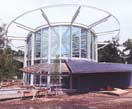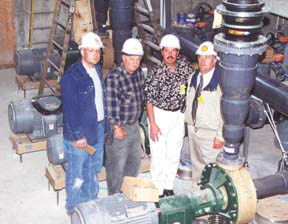In the swamp or on an ice floe, zoo animals will feel right at home
Date Posted: June 23 2000
It's a good time to be a polar bear or a frog at the Detroit Zoo.
The contracting team of Turner/White and the building trades are in the process of building two separate, major upgrades at the zoo that will put Arctic wildlife and amphibians into enhanced habitats, while giving human visitors views of the animals that they've never had before.
"This is fantastically interesting work," said Robert Sanders, project superintendent for Turner. "We've been introduced to a new way of constructing."
The larger of the two projects is the "Arctic Ring of Life" exhibit, a $13.6 million interactive facility that will include more than four acres of outdoor and indoor displays. In addition to a variety of flora and fauna, the exhibit, set to open in the fall, will explore the relationship between Arctic people (Inuits) and wildlife.
"This has some pretty extreme mechanical work, and the job has pretty close to the biggest chillers we've even installed," said Mike Johnson, a pipe fitter and owner of Johnson Mechanical. "We're constantly testing the lines to make sure we don't have any leaks, because if we find any after we're done, the tear-out would just be tremendous."
The display recreates an open tundra setting, where visitors will encounter arctic foxes, snowy owls, and polar bears. In the Nunavut gallery, an indoor viewing area, displays will include Inuit art and artifacts. Visitors will be able to walk a 70-foot long, 12-foot wide clear tunnel that will allow views underneath diving and swimming polar bears and seals.
So that the seals don't become an instant breakfast for the polar bears, the two species will be separated by a transparent barrier. Visitors will then arrive in an "ice world," passing a frigid ice cave, igloo, and an exploration station featuring real icebergs made for bears.
From the building trades' standpoint, recreating the arctic environment is the biggest challenge.
It's become second-nature to keep most homes or office buildings at a constant 72 degrees for optimum human comfort - but it's a whole other world to make a varied environment comfortable for polar bears. A huge icemaker provides the animals with small icebergs in the water. Sand filter de-ionizers and ultraviolet sterilizers are part of an ultra-sophisticated water filtration system. And pumps will circulate the system's 294,000 gallons of salt water and 30,000 gallons of fresh water.
"I'm used to traditional plumbing, but what we're doing here is a little different," said Plumbers Local 98 foremen Richard Junod. Creating a natural environment for polar bears "is not something we do every day," he said.
Complicating the entire project is the use of saltwater throughout the Arctic Ring of Life. All plumbing fixtures have to be noncorrosive, so that means the trades are installing stainless steel, plastic pipe and fiberglass fixtures.
Conditions will be a little warmer a quarter-mile away in the National Amphibian Conservation Center. The 12,000-square-foot, $6.3 million gallery will house about 100 species and 1,000 specimens of amphibians from around the earth - the largest group of amphibians in captivity.
The center "will be unlike anything anywhere," said Herpetology Curator Andy Snider. "No other zoological institution has a major facility dedicated entirely to amphibians. Scientists will have the ability to come here from all over the world to help study and save amphibians. We hope this center will serve as a model."
The exhibit will include rarities like the world's largest salamanders (reaching five feet and 50 lbs.) and the most unusual frogs and toads.
The trades are creating an immersion gallery featuring the Peruvian Amazon, with free-ranging birds, turtles and amphibians. In later years, the gallery will be changed to another ecosystem like the Florida Everglades. The gallery will be able to recreate rainfalls, wind, fog, and lightning.

THE AMPHIBIAN exhibit is designed to look like a lily pad.

IN THE PUMP ROOM of the Detroit Zoo's Arctic Ring of Life are (l-r) foreman Richard Junod and Chuck Olesak of Plumbers Local 98, Johnson Mechanical owner Mike Johnson, and Business Agent Chuck Inman of Pipe Fitters, Refrigeration and Air Conditioning Service Local 636. The filtration pumps can move 90,000 gallons of very chilled water in 67 minutes.
